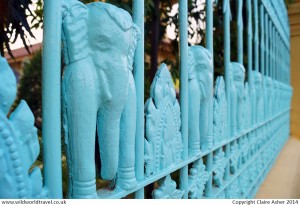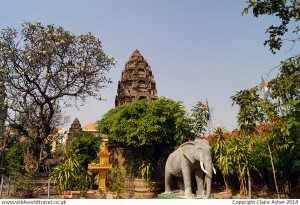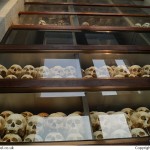We took the day bus up from Sihanoukville to Phnom Penh and arrived around midday, Sam was feeling very ill at this point but we still needed to find our accommodation and check in before he could rest. We managed to get a tuk tuk to take us from the bus stop to the hostel we’d booked, although it was quite a way out of town and took ages to find. We’d had a hard time finding a suitable place when we were booking, and the map and road names were totally confusing – many of the roads are numbered rather than named but for some reason do not seem to be numbered chronologically with respect to geography. Arriving at the hostel, finally, we checked in and I put Sam to bed.
 Bored, and lacking a sightseeing companion, I decided to try and make myself useful while Sam recovered. I got a map from reception and headed out in search of a post office. We were still carrying around all the souvenirs we’d failed to post back from Ho Chi Minh City so I was hoping we’d be able to post some off from here. There was a post office marked on the map just a few blocks from the hostel, and I figured this was a good way to orientate myself. It was oppressively hot in the midday Cambodian sunshine, and I wandered up and down the busy main street (on which the post office was supposedly located) for over an hour before concluding that the map was wrong. I even asked a few locals but they said there hadn’t been a post office around there in years. I headed back to the hostel hoping Sam would be feeling better. He wasn’t much better, but I managed to convince him to come out and get some dinner with me. So we hailed a tuk tuk and headed towards the centre of town, to an area by the river front where there were a lot of bars and restaurants. I paid the tuk tuk driver and by the time I had sorted that out I turned to see Sam hunched over sat on the wall by the side of the river. He wasn’t well. I went to get some bottled water and check out the restaurants across the street, but when I returned it was clear Sam wasn’t up to going to a restaurant. So we got another tuk tuk back to the hotel and he went to bed. Still hungry, I went out in search of food. The area we were staying in wasn’t great. and the one or two ‘restaurants’ I’d seen nearby were closed by now. I walked towards the main high street in this area and stumbled upon a street vendor from whom I bought some noodles. I stopped on my way back to buy a couple of beers – it was Friday and I needed to take my Friday photo. I got back to the hostel and ate my dinner on the balcony overlooking a fairly unimpressive street below, and went to bed.
Bored, and lacking a sightseeing companion, I decided to try and make myself useful while Sam recovered. I got a map from reception and headed out in search of a post office. We were still carrying around all the souvenirs we’d failed to post back from Ho Chi Minh City so I was hoping we’d be able to post some off from here. There was a post office marked on the map just a few blocks from the hostel, and I figured this was a good way to orientate myself. It was oppressively hot in the midday Cambodian sunshine, and I wandered up and down the busy main street (on which the post office was supposedly located) for over an hour before concluding that the map was wrong. I even asked a few locals but they said there hadn’t been a post office around there in years. I headed back to the hostel hoping Sam would be feeling better. He wasn’t much better, but I managed to convince him to come out and get some dinner with me. So we hailed a tuk tuk and headed towards the centre of town, to an area by the river front where there were a lot of bars and restaurants. I paid the tuk tuk driver and by the time I had sorted that out I turned to see Sam hunched over sat on the wall by the side of the river. He wasn’t well. I went to get some bottled water and check out the restaurants across the street, but when I returned it was clear Sam wasn’t up to going to a restaurant. So we got another tuk tuk back to the hotel and he went to bed. Still hungry, I went out in search of food. The area we were staying in wasn’t great. and the one or two ‘restaurants’ I’d seen nearby were closed by now. I walked towards the main high street in this area and stumbled upon a street vendor from whom I bought some noodles. I stopped on my way back to buy a couple of beers – it was Friday and I needed to take my Friday photo. I got back to the hostel and ate my dinner on the balcony overlooking a fairly unimpressive street below, and went to bed.
The following day Sam was feeling a little better, and since it was the last day we were planning to spend in Phnom Penh, I dragged him out of the hostel and into town. First stop on our mission was the post office. This time we had the tuk tuk driver take us straight to the central post office, and thankfully it was open! We both managed to get parcels sent off, although for about four times the price I’d paid in Hanoi. We left the post office feeling light and satisfied. After some lunch at a restaurant by the river, we decided to walk south towards the Royal Palace, and visit some temples on the way.  Coming out of one of these temples, a very enthusiastic tuk tuk driver accosted us. He asked us what we were planning to do next, and when we replied that we were thinking we might go to the Royal Palace next, he informed us that we wouldn’t be allowed in wearing shorts and that it was closing soon anyway, better to go tomorrow instead, and come with him now to see the Killing Fields. We chatted for a bit and tried to resist but he was persistent. I wanted to go, but I was aware Sam probably didn’t feel up to it. Whether he was or wasn’t, the tuk tuk driver eventually won and after we’d bought a couple of large bottles of water to take with us, we climbed into the tuk tuk and set off. Pleasingly, we drove past a number of sights I’d wanted to see on our way, before heading out of town and onto the bumpy dirt tracks that led out to the famous Killing Fields.
Coming out of one of these temples, a very enthusiastic tuk tuk driver accosted us. He asked us what we were planning to do next, and when we replied that we were thinking we might go to the Royal Palace next, he informed us that we wouldn’t be allowed in wearing shorts and that it was closing soon anyway, better to go tomorrow instead, and come with him now to see the Killing Fields. We chatted for a bit and tried to resist but he was persistent. I wanted to go, but I was aware Sam probably didn’t feel up to it. Whether he was or wasn’t, the tuk tuk driver eventually won and after we’d bought a couple of large bottles of water to take with us, we climbed into the tuk tuk and set off. Pleasingly, we drove past a number of sights I’d wanted to see on our way, before heading out of town and onto the bumpy dirt tracks that led out to the famous Killing Fields.
We stopped first along the way to visit the Cambodian military shooting range, basically a must-see for tourists visiting Cambodia (apparently!). Here you can pay quite a hefty fee to fire one of a range of different guns and weapons. I wasn’t prepared to pay the fee, but Sam was and he had a go on an AK47. Afterwards the men running the place insisted that we both pose for photos with the guns they had. It was all a little bit strange. Back in the tuk tuk and onwards to the Killing Fields – Choeung Ek.
The Killing Fields were another of those experiences that you don’t look forward to, you know you won’t enjoy, but you equally know are very important. It amazes me that the entirety of my school education had failed to ever mention even a whisper of the horrors that happened in Cambodia only a few decades ago. Visiting the Killing Fields was a shocking introduction to this part of Indochina’s history. This site must be one of the rawest, most recent sites of genocide. It is so fresh that even now, rain and consequent erosion is bringing out clothes, bones and teeth from the ground. The contrast between that and the superficial tranquility and beauty of the place is stark. It is not an easy place to be. The free audio commentary was fascinating, but not easy to listen to. For a few minutes, Sam and I distracted ourselves with a brightly coloured spider that was sat on one of the many benches.
At Choeung Ek, between 1975 and 1979, an estimated 17,000 Cambodian people were executed as part of Pol Pots Khmer Rough regime. Choeung Ek is just one of around 300 killing fields were over a million ordinary Cambodians were brutal murdered. The genocide committed by the Khmer Rough, along with disease and starvation largely resulting from their policies, are thought to have killed as many as 2 million people (around a quarter of the Cambodian population at the time). Around 9000 bodies have been exhumed at Choeung Ek, however it is unknown how many more lie in untouched mass graves which are evident as large mounds of earth throughout the site. Probably most horrifying is the Chankiri tree, where children were beaten to death by Khmer Rouge soldiers. They were the children of those accused of ‘crimes’ against the regime, and were killed to ensure nobody would survive to seek revenge. This and other sites around Choeung Ek are covered in bracelets hung by visitors as a form of memorial.
Leaving the Killing Fields, we woke up our tuk tuk driver and he took us back to town. We were debating whether we should go back to the hostel or into town. We wondered if we were too British to ask him to change the destination half way through the journey. When he started to get lost finding our hostel we saw our opportunity, and asked him to take us into town instead for dinner.
The following morning we were due to check out of the hostel, and were booked on a bus to Siem Reap. When we woke up, early, Sam complained he wasn’t well enough to get the bus. I wasn’t sure what to do, but when I got out of bed I realised I didn’t feel well either, and we quickly concluded that we were in no fit state to get on a bus all day. I drew the short straw and had to go down to reception and explain and ask them to cancel our bus tickets and could we stay another night? We couldn’t. They were booked up. Damn. But they could offer us a similar room for the same price in another hostel in town that was owned by the same person. A tuk tuk would arrive shortly to take us there. Fine.
So we grudgingly packed up our stuff and brought it down to the lobby. Soon a tuk tuk arrived and we realised we weren’t the only people doing this – there were at least 7 of us in the lobby, and we eventually split up into two tuk tuks. This meant Sam and I and our luggage had to share a tuk tuk with an Australian guy and all his luggage. It was cosy, to say the least. Somehow the tuk tuk’s motorbike engine was able to pull all that weight, and we set off. About 10 minutes later we pulled up at our new hostel. It was immediately clear we were in a far better location, much closer to town now, and the rooms turned out to be larger and nicer than the last place. It was a pity we were only here one night.
We both had some rehydration salts and decided to try and do something with our extra day in Phnom Penh. We wandered out into the afternoon heat to check out some markets nearby. We saw a couple of markets that were just beginning to close, and then found one night market. None of them were particularly exciting and we came away almost empty handed.
We grabbed some dinner along the riverside and decided we both felt well enough finally to go out and see some of the bars in Phnom Penh. Unfortunately, what we mostly found was the seedier side of Phnom Penh – a lot of bars which were very clearly catering to a specific tourist demographic: western men. If you know what I mean…
The next morning we had to check out of our hostel at 10am, but we’d booked ourselves onto a night bus to Siem Reap that evening, so we left our bags in the lobby and headed out for one final day in Phnom Penh. Sam had found a leaflet for a traditional knife shop, and keen to get a souvenir, he dragged us off to find the place. It wasn’t actually too hard to find, only a few blocks from our hostel on the river front. We had a look around and although Sam failed to find a knife that took his fancy, I ended up buying a pendant in the shape of the Chinese symbol for Rabbit – the Chinese year I was born.
We grabbed a late breakfast and then had another wander around some of the markets nearby. The markets were exhausting – bustling and hot, with the constant murmur of people trying to sell you things. Look at any one item or stall for more than a few seconds and the stall owner will pounce. I managed to get a chain for my pendant and haggle a reasonably OK price and we left, feeling rather drained.
We still hadn’t made it into the Royal Palace, and I really wanted to go, so we headed back to the hostel to go and get changed into Palace-appropriate attire (no exposed knees or shoulders). The day was getting on though, and I tried to rush things along so we wouldn’t miss it. Unfortunately, my concerns were not unfounded as when we got to the palace at around 4.30pm, it was closed. Disappointed, we tried to make the best of things by walking along outside the palace and the temples that surround it and peeping in through the gates to watch the sun set behind the golden spires.
For some reason, we stumbled upon a man who had some kind of remote-controlled flying… thing. It wasn’t a plane, exactly, it looked very robotic, and legs on it’s sides suggested it might also be able to walk, although we never saw that. But it flew very well, and a crowd began to gather watching it fly. I was amazed that the police didn’t have anything to say about it – there were some stationed in the street only a few meters away. The police presence in Phnom Penh was pretty noticeable while we there, most likely because of riots that had happened in the capital only a day or two before we arrived.
With only a few hours left before our late-night bus to Siem Reap, we had a nice afternoon beer in the fading sunshine outside a bar on the riverfront, and then found a restaurant around the corner for some dinner. For some reason, I think there was an offer on or something, we ordered a pitcher of Cambodia beer. Sam quickly decided he wasn’t really well enough to drink beer yet, though, so I ended up having to finish the entire thing! With me feeling a little merry, we walked back to the hostel, gathered our things outside and waited to be collected for our bus. We were taken to the bus depot where we got on board and made a rather wonderful discovery – we’d inadvertently bought tickets for a ‘Hotel bus’ which meant we’d get a flat bed to sleep on in a private compartment. Jackpot! Perhaps this long-distance bus journey wouldn’t be as unbearable as the last.

